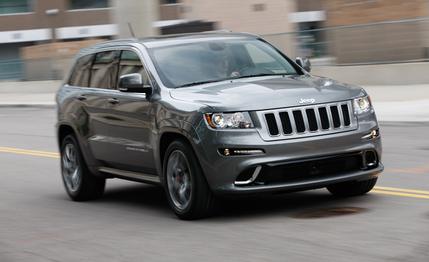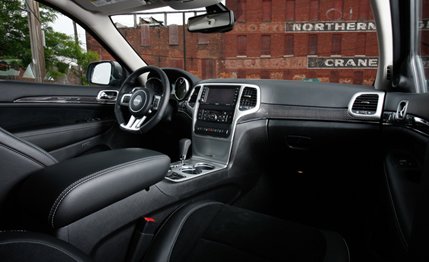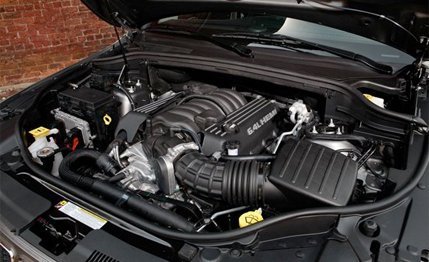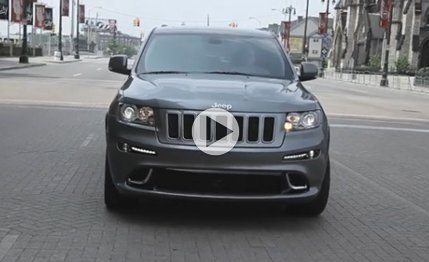 Instrumented Test
Instrumented Test

Four is the new three, as in $4 and 40 highway miles per gallon. But come hell or high gas prices, there will always be hot cars, mighty trucks, and a privileged few who don’t sweat $100 fill-ups as long as the passing lane remains open for business.
Back from some engineering R & R, the Jeep Grand Cherokee SRT8 lives for express-lane service. Like the rest of the Cherokee nation, it rolls on a new platform that began life as a Benz but was nurtured by a Chrysler team with a name that says it all. Good luck convincing apprehending officers that the SRT badge on the back of this Jeep stands for Slow, Reserved, and Timid, rather than Street and Racing Technology.

Inflation Affects Us All
The second-gen version of the Jeep with the nerve to taunt the world’s premium SUVs unfortunately suffers from another type of inflation unrelated to its estimated $50,000 base price. As if air nozzles were jammed up its exhaust pipes, the new SRT8’s walls are bowed out 3.8 inches, the roof towers 2.4 inches higher, and the wheelbase is 5.3 inches longer than its 2006–10 predecessor’s. Fashionably clipped overhangs do result in a 3.7-inch-shorter overall length, though.
Inside, the architectural changes net a modest gain in front-seat travel, 3.1 inches of additional rear legroom, and a touch more cargo space. In keeping with Chrysler’s current interior-upgrade initiative, the SRT8’s cabin received a rich overlay of (optional) French-stitched leather and suede, genuine carbon-fiber trim, and elegantly polished metal-look accents. Navigation displayed on a 6.5-inch, tilting touch screen with a media hard drive is standard, as are an MP3 playback function and auxiliary media connections. To provide more storage space in the center console, the parking brake moves from hand to foot operation.

Since curb weight is up nearly a quarter-ton over the 2010 SRT8 that finished third behind BMW’s X5 M and Porsche’s Cayenne Turbo S and ahead of Land Rover’s Range Rover Sport Supercharged in our January 2010 comparo, the SRT sorcerers had their work cut out upgrading the hardware. A significantly stiffer body structure and a new independent rear suspension provide an excellent foundation. To fight the extra weight, the faithful Hemi V-8 has been muscled up with larger bore and stroke dimensions yielding 6.4 liters, 50 additional horsepower (470 at 6000 rpm), and 45 more pound-feet of torque (now 465 at 4300 rpm). One carry-over is an anachronistic five-speed automatic, at least blessed with thumb-sized, steering-wheel-mounted paddle shifters. (Be patient, SRT8 fans: Chrysler has an eight-speed autobox coming soon.)
What’s now called “Fuel Saver Technology” (formerly Multi-Displacement System) allows the Hemi to cruise on only four firing cylinders, signaled by an “eco” lamp in the instrument cluster. It works at speeds of up to 82 mph and, along with slightly taller gearing, helps to boost the SRT8’s EPA highway-mileage rating from 16 mpg to an estimated 18.

The SRT gang dipped heavily into Fiat’s engineering budget for premium chassis and powertrain components. The electronically controlled Quadra-Trac transfer case automatically adjusts the amount of torque delivered to the front axle to maximize available traction. The limited-slip rear differential is also processor-managed. Massive Brembo calipers grip 15.0-inch front and 13.8-inch rear brake rotors, while adaptive Bilstein dampers do a superior job of managing body motions without trashing the ride.
A console-mounted Selec-Trac master knob commands the damping, stability control, torque distribution, shift strategy, throttle response, and cylinder deactivation according to the driver’s choice of five settings: auto, sport, track, tow, and snow. To facilitate expeditious marine ops, a Class IV receiver hitch and appropriate trailer wiring are now offered as a factory option. Also worth playing with is a menu of “performance pages” in the info center, which is located between the tach and speedometer. The system is capable of displaying a whole road test’s worth of numbers—various acceleration figures, braking distance, cornering and braking g—plus oil pressure and temperature, transmission temp, and engine hours.
